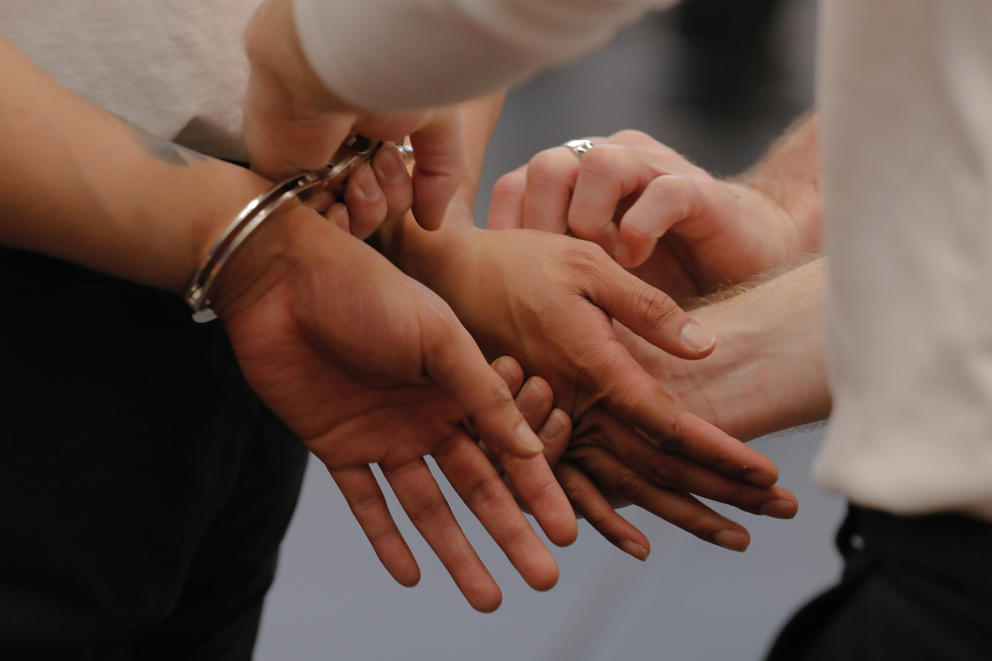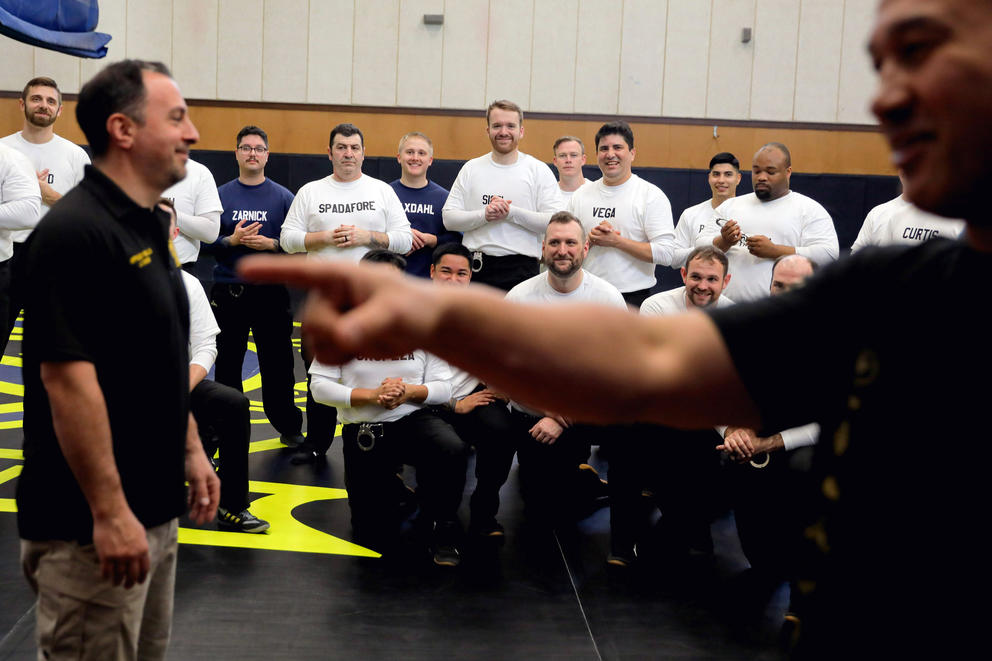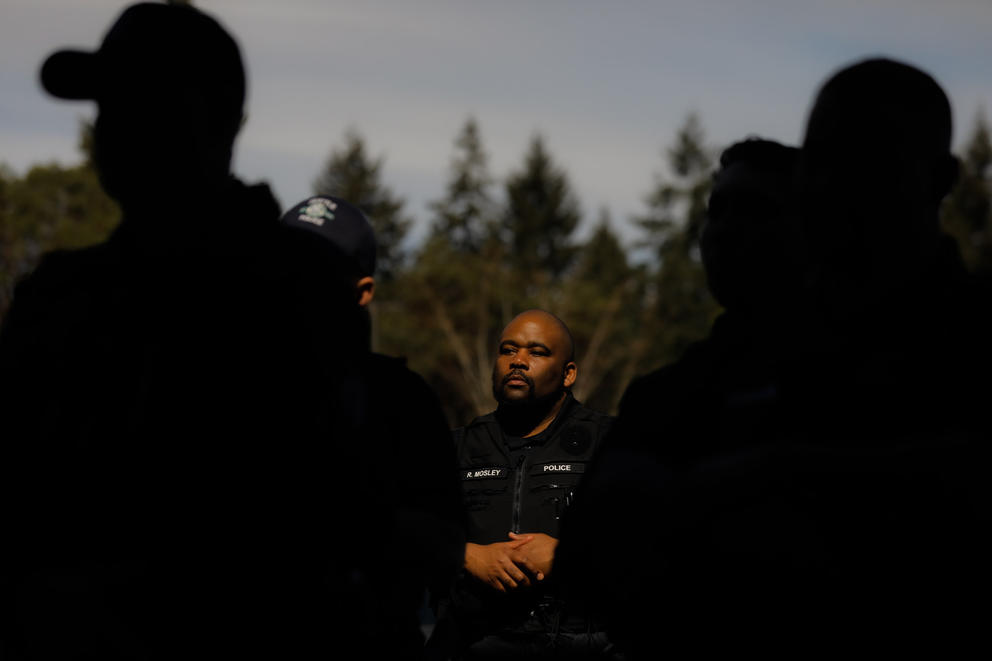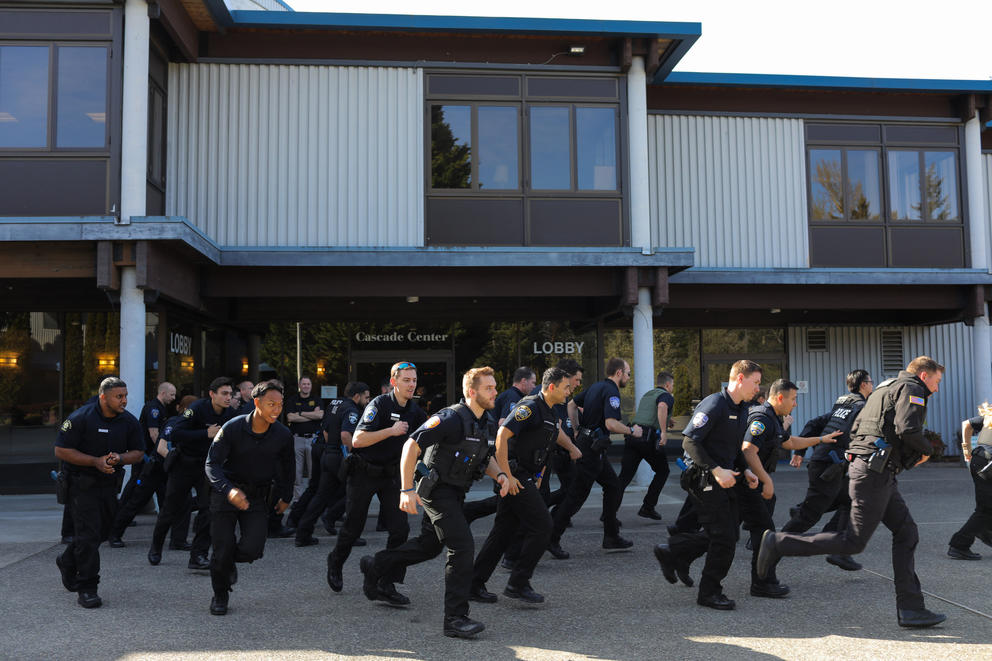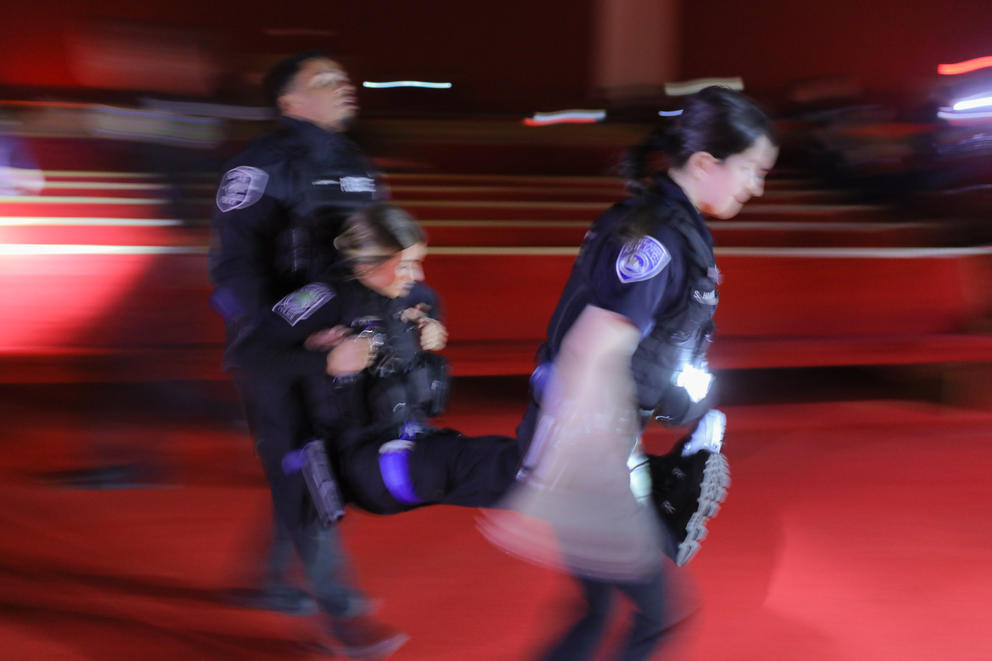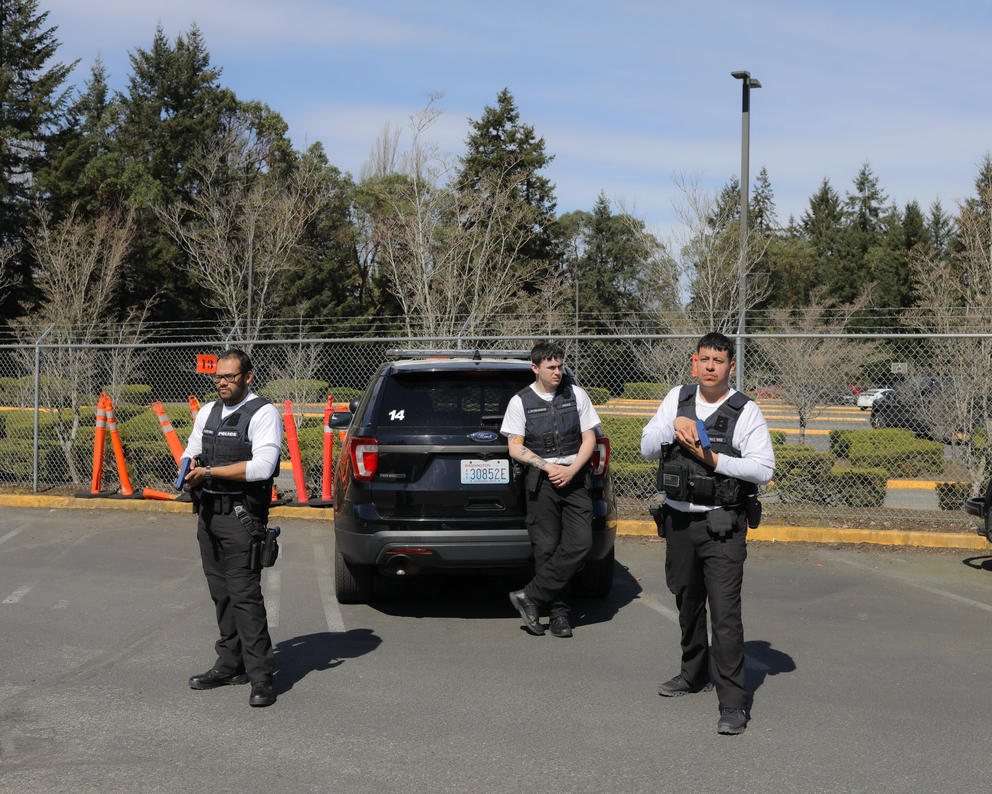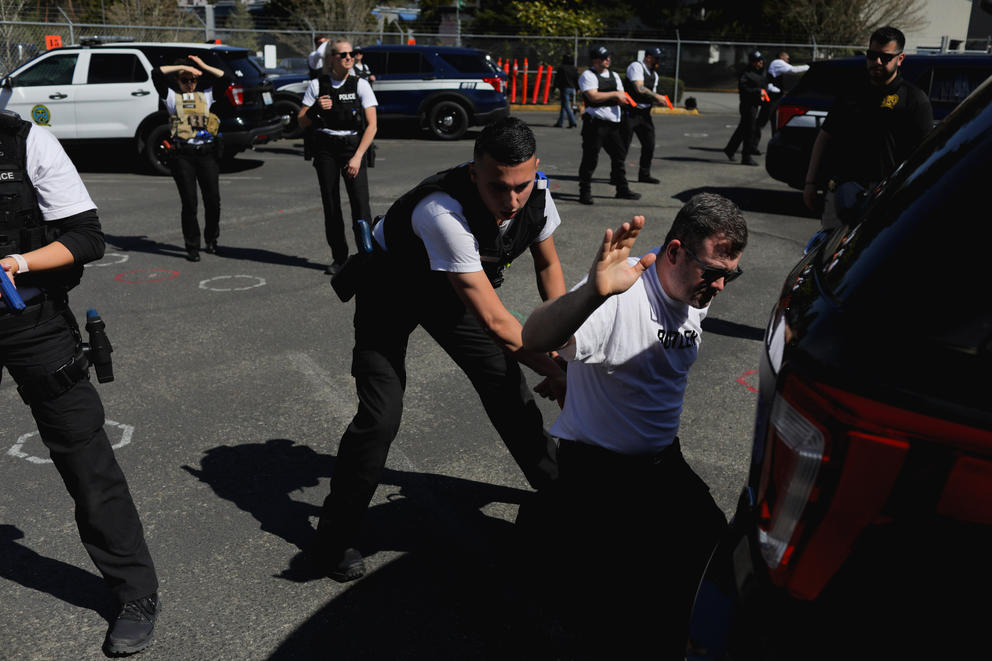“When police arrest a suspect, they’re always emotional, always upset,” said Rich Peterson, program manager for use of force and defensive tactics at Washington’s Criminal Justice Training Center in Burien.
The handcuffing lesson came just after warm-up exercises for recruits at the Center on a recent Tuesday. Breaking your fall when knocked down. Tumbling if pushed forward. Scooching away from an attacker, on your back without using your arms.
The Center is doing its best not to be an obstacle between officer hiring and getting cops out on the streets. But the work is a big commitment for the trainee, the state of Washington and the Center.
The four-and-a-half-month course includes 720 classroom and training hours. Subjects include patrolling, psychology, field tactics, driving, communication and de-escalation skills, criminal law, serving court orders, searches and seizures, Miranda warnings, crime scene procedures, firearms training, control and defensive tactics, traffic training and other topics.
The Center is trying to train police recruits in the greatest numbers possible because Washington is short on cops and deputies. In fact, Washington has the lowest ratio of law enforcement officers to civilians in the nation at 1.12 per 1,000 people, down from 1.23 in 2019, according to the Washington Association of Sheriffs and Police Chiefs. The national average is 2.3, according to the FBI.
Seattle’s police department did not respond to Cascade PBS’s request for current statistics. A March KING 5 television report said Seattle Police staffing is at a 30-year low, with 913 active officers and a need for 375 more. In 2022, when the City Council was considering hiring bonuses to attract more police recruits, the police department said it had lost nearly 400 officers since January 2020, hiring only 145 in that same timeframe. A national trend mirrors Seattle’s experience, with U.S. police departments losing officers to resignations and retirement far faster than they can hire replacements.
“I’ve heard such an outcry for public safety from constituents,” said Rep. Chris Stearns, D-Auburn, at a Jan. 16 hearing before the House Local Government Committee on his proposal to allow some cities to increase their sales taxes by a small fraction to help pay for police. House Bill 2211 did not go anywhere.
“Safety staffing is at a crisis point for our state,” said Puyallup Police Chief Scott Engle at another Jan. 16 hearing on a similar measure, House Bill 2231.
No one can intelligently speculate why Washington is dead last in police staffing. “I don’t know the answer. Every department is having the same problem statewide,” said Barbara Serrano, Gov. Jay Inslee’s policy advisor on public safety issues.
But experts can generalize why officers are dropping out of the profession here and elsewhere.
Reasons for leaving include job pressures, burnout, frustrations, the fluctuating stigmas of being a cop, bad hours for raising a family, sometimes long commutes because an officer cannot afford to live in the city they are protecting and a lack of local money to hire new law enforcement officers.
“More and more are just choosing to leave,” said Steve Strachan, executive director of the Washington Association of Sheriffs and Police Chiefs. But as more officers leave, the ones who remain are more likely to feel the pressures of burnout, which could lead to more departures. “It’s this downward spiral,” Strachan said.
Two bottlenecks have hampered Washington’s ability to add law enforcement officers: One is not enough training capacity, the other is that local governments lack money to add more officers. And while hiring is essential, Serrano believes retention is key.
“We need to get creative at both the local level and at the state level on retaining officers. Law enforcement is competing with everyone else out there [on hiring],” she said.
Meanwhile, Washington — which has 10,393 sworn officers, deputies and state troopers — also is not clear on how many new cops are needed, other than emphasizing that a serious push is needed.
Monica Alexander, head of Washington’s Criminal Justice Training Center, is frustrated that the lack of clarity on how many new officers are needed hampers the Center’s ability to plan long-term.
Individual local governments with different budget pictures and varying political leanings have different views on how many police officers are needed now and in the near future for their communities, Strachan said.
Police recruits Emma Yamamoto and Kirbi Music at the Burien training center are aware of the stresses they will face.
Seattle Police Department recruit Yamamoto, 27, comes from a cop family. Her dad is a 37-year veteran sergeant in the Seattle Police Department’s harbor patrol. Her uncle recently retired from the Washington State Patrol. “It was ingrained early in me. … There were a lot of mental barriers to overcome,” she said.
Yamamoto was an orientation program manager at the University of Washington when 2020 happened — the Black Lives Matter marches and the subsequent protests that led to the Capitol Hill Occupied Protest zone. Her dad was feeling the pressure as a police officer, and she also felt stressed working at a university where people frequently criticized police. “CHOP was a whole family experience,” she recalled.
“When you put on the uniform, you expect some of the burdens of the uniform. I still believe that me as an officer can make a [good] impression of law enforcement” on the public, she said.
Music, 32, of Oak Harbor, wanted to be a K-9 cop since she was a teen. She joined the U.S. Navy with hopes of becoming a master at arms, and the Navy, in typical military fashion, made her an aviation mechanic. After several years in the military, she connected with the Mount Vernon police to do some ride-alongs because they had some available, and fell in love with that department so much that she was willing to commute from Oak Harbor — where she lives with her husband and three kids — to Mount Vernon.
During the ride-alongs, Music picked up on the long hours and tensions that come with the job. “You can’t bring it home with you,” she said.
For years, the Burien training center had been the sole such facility in Washington. It is required to train 20 classes of 30 recruits a year, but those 600 trainees are not enough to fill Washington’s needs even though the Center has more than doubled the number of classes it offered two years ago, Alexander said. The male-to-female ratio fluctuates from class to class, but if Yamamoto and Music are any indication, policing is clearly no longer a field open only to men.
In 2022, the Criminal Justice Training Center added a campus in Spokane. This year, other satellite centers started operating in Pasco and Vancouver. Another is expected to open in Arlington later this year. One of the hurdles to training recruits is that it is difficult for many — especially those with children — to spend four and a half months in Burien. The satellite campuses are designed to address that while raising the total capacity to train 870 police recruits in 2025, plus 800 correctional officers, misdemeanor probation officers and other roles.
Another improvement is that it no longer costs local law enforcement to send their recruits in for training. Until this year, local police and sheriff’s departments had to pay 25% of the training costs for each recruit. After legislative action this year, the state is paying 100% of the bill.
Despite the increase in statewide training capacity, the Burien training center still has a waiting list of 161.
“We’re straining at the seams,” Alexander said. The Center will soon start evaluating sites in Federal Way and Auburn as a new home for its main facility, with a June 30 deadline for making that recommendation. The Center has to move because the Burien site does not have room to physically expand. Alexander wants to have the new larger main training center operational in three years.
Meanwhile, the Legislature has stalled on providing extra money to local governments to hire more officers: Bills to allow local governments to add small amounts to their sales taxes or reroute existing sales tax revenue to law enforcement never made it out of committee in either the 2023 or 2024 legislative sessions.
“The underlying problem is that the public is very anti-tax. … The general feeling is a property tax is a little more fair than a sales tax,” said Sen. Karen Keiser, D-Des Moines, whose Senate Bill 6076 to route some sales tax revenue to public safety died in committee.
Sen. Jamie Pedersen, D-Seattle, introduced Senate Bill 5770 earlier this year to allow local governments to increase property tax from 1% a year to 3%. That bill teetered on the brink of a full Senate vote, but didn’t make it.
“In an election year, a bill to let local governments raise property taxes is a hard sell. … It looked like we had the votes in the Senate and then we didn’t have the votes,” Pedersen said.
Pedersen is unsure if he will try to revive SB 5770 for the 2025 session. The big tax question for the Legislature is how the public will vote in November on initiatives to repeal the state’s new cap-and-invest program and its capital gains tax. These are huge new revenue producers for the state’s climate change, transportation, health and education programs. Losing them will have a major ripple effect on what money is available for the entire 2025-2027 biennial budget and whether a property tax proposal to help pay for public safety will be considered, Pedersen said.
Another proposal by Rep Drew Stokesbary, R-Auburn, to appropriate $90 million out of the state’s general fund to hire more officers, House Bill 1446, died in committee with Stokesbary in the dark.
However, Democratic gubernatorial candidate Bob Ferguson, currently Washington’s attorney general, is proposing to allocate $100 million to local governments to hire new officers.
Republican gubernatorial candidate Semi Bird’s campaign said he would address the police shortage by creating a pipeline from high school to law enforcement agencies and by honoring officer certifications from other states. The campaigns of Republican Dave Reichert and Democrat Mark Mullet did not respond to Cascade PBS’s requests for information on this subject.


